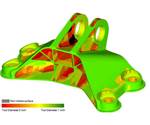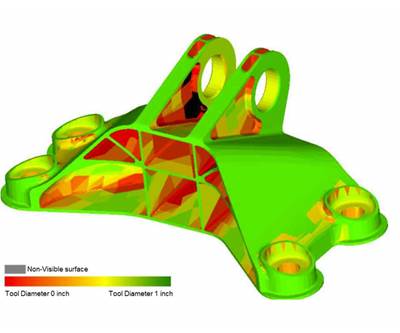Postprocessing Steps and Costs for Metal 3D Printing
When your metal part is done 3D printing, you just pull it out of the machine and start using it, right? Not exactly.
A metal additive manufacturing (AM) part is essentially “welded” to the build plate, and you will not be able to pull it off without some assistance. Even then, the AM part will need postprocessing before it is ready to use. Here are some steps and costs associated with postprocessing AM parts.
Powder Removal
AM parts build “down” in a powder-bed fusion system as new layers are added to the top, which means that parts are buried in powder when they are done (see Figure 1). After the build has finished and the parts/build plate have cooled, the machine operator has to remove all of the powder from the build volume and sieve/filter/recycle it for later use, assuming you want to reuse it. This is not an expensive step, but it does take time.
Stress Relief
The heating and cooling of the metal as the part builds layer-by-layer leads to internal stresses that must be relieved before the part is removed from the build plate. Otherwise, the part may warp or even crack. Stress-relieving the part requires an oven or furnace (preferably with environmental controls) that is big enough to fit the entire build plate. Many recommend using an oven with an inert environment to minimize oxidation on the part surface. Others prefer a vacuum furnace, which costs a lot more ($100,000 versus $10,000 to $30,000). Stress-relieving a batch of parts typically costs $500 to $600, plus shipping.
Part Removal
Most companies use wire EDM to remove parts from the build plate, however many machine shops are starting to use a bandsaw (see Figure 2) because it is faster and the bottoms of the parts must be finished anyway. Keep in mind that materials such as Inconel strain-harden as they are worked, making it difficult to remove them from the build plate with just a bandsaw. Using a local machine shop, we spend about $200 to $300 per plate for wire EDM, which can take a few hours depending on the number and size of the parts. A bandsaw can complete the task in minutes.
Heat Treatment
Heat treatment (aging, solution annealing and so on) improves the microstructure and mechanical properties of the parts and is necessary for nearly all AM parts. In many cases, this step also requires an environmentally controlled furnace with the ability to regulate the temperature and cool-down schedule. Heat treatment may affect the dimensions of the parts, so most people prefer to heat-treat parts before they machine/finish them. The American Society for Testing and Materials (ASTM) released a standard for thermal postprocessing of metal AM parts. Heat treatment can easily cost $500 to $2,000 depending on the material and how many parts are being treated.
Hot Isostatic Pressing
Instead of heat treatment, many aerospace companies are starting to use hot isostatic pressing (HIP), which is frequently used in the casting industry to improve the fatigue life of cast parts. A HIP system costs substantially more than a furnace/oven and comes with its own safety measures due to the high pressures (100 megapascals or more) at which it operates. Like heat treatment, HIP costs $500 to $2,000, but you often do not need to heat treat the part if you HIP it.
Machining
Machining of mating interfaces, surfaces, threads, support structures and more likely will be required to ensure dimensional accuracy of the finished part (see Figure 3). Few AM parts meet specifications “as built,” and if nothing else, the surface of the part that was connected to the build plate will need to be finished. Most manufacturing companies already have machining systems on hand, but registering parts and establishing datums for machining can be tricky, especially for complex, organically shaped parts made with AM. Accessing internal channels or cooling passages that need to be machined can also increase costs. The cost here is highly dependent on the material and the job as well as the fixturing needed to hold the part.
Surface Treatments
Surface finishing also might be required to improve surface finish/quality, reduce surface roughness, clean internal channels or remove partially melted particles on a part. When outsourced, these costs can easily run in the hundreds if not thousands of dollars.
Inspection and Testing
Metrology, inspection and nondestructive testing using white/blue-light scanning, dye-penetrant testing, ultrasonic testing, computed tomography (CT) scanning and more will be needed after post processing and possibly at multiple points during post processing. Destructive testing of sample parts and analysis of witness coupons (for example, tensile bars), powder chemistry, material microstructure and more also may be needed to gather data to help with process qualification and ultimately part certification.
Most companies will have a range of metrology and non-destructive testing methods on hand, but AM parts with internal channels, lattice structures and other internal enhancements may require CT scanning to ensure clear passageways, evaluation of internal geometries and more. A CT scanner will easily cost $1 million to buy, install and operate.
This article originally appeared in Additive Insights (May 21, 2018), a monthly column in Modern Machine Shop magazine.
Related Content
What is Powder Bed Fusion 3D Printing?
Whether in metal or polymer, with a laser or an electron beam, powder bed fusion (PBF) is one of the most widely used 3D printing techniques.
Read MoreUnderstanding HP's Metal Jet: Beyond Part Geometry, Now It's About Modularity, Automation and Scale
Since introducing its metal binder jetting platform at IMTS in 2018, HP has made significant strides to commercialize the technology as a serial production solution. We got an early preview of the just-announced Metal Jet S100.
Read More8 Cool Parts From Formnext 2023: The Cool Parts Show #65
New additive manufacturing technologies on display at Formnext were in many cases producing notable end-use components. Here are some of the coolest parts we found at this year’s show.
Read MoreHow to Build 10,000+ Shot Molds in Hours
Rapid tooling isn’t so rapid when it takes days to 3D print a metal mold, and then you still must machine it to reach the necessary tolerances. With Nexa3D’s polymer process you can print a mold in hours that is prototype or production ready and can last for more than 10,000 shots.
Read MoreRead Next
3D Printing with Postprocessing in Mind
3D printing requires different finishing considerations than traditional manufacturing. One expert offers do’s and don’ts for approaching the finishing of additively manufactured parts.
Read MoreCan My Machine Tool Access My Support Structures?
Analyzing the machinability of support structures opens a new way of thinking about optimal build orientation.
Read More3D Printing Brings Sustainability, Accessibility to Glass Manufacturing
Australian startup Maple Glass Printing has developed a process for extruding glass into artwork, lab implements and architectural elements. Along the way, the company has also found more efficient ways of recycling this material.
Read More





















